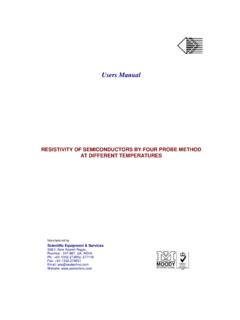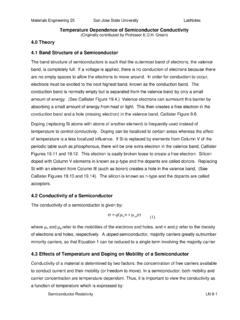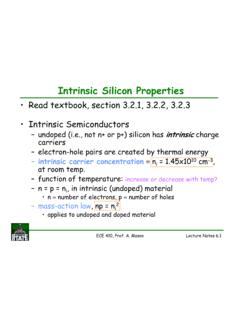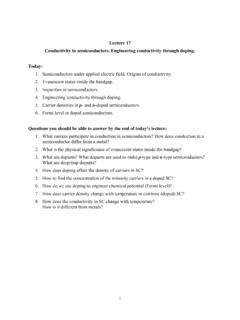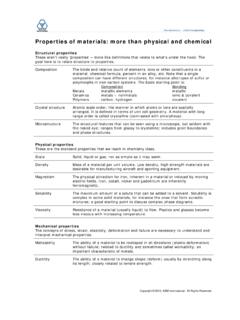Transcription of RESISTIVITY OF SEMICONDUCTORS BY FOUR PROBE …
1 Users Manual RESISTIVITY OF SEMICONDUCTORS BY FOUR PROBE METHOD AT DIFFERENT TEMPERATURES Manufactured by .. Scientific Equipment & Services 358/1, New Adarsh Nagar, Roorkee - 247 667, UA, INDIA Ph.: +91-1332-272852, 277118 Fax: +91-1332-274831 Email: Website: MOODYINTERNATIONALUKASQUALITYMANAGEMENT0 14 INTRODUCTION The properties of the bulk material used for the fabrication of transistors and other semiconductor devices are essential in determining the characteristics of the completed devices. RESISTIVITY and lifetime (of minority carriers) measurements are generally made on germanium crystals to determine their suitability. The RESISTIVITY , in particular, must be measured accurately since its value is critical in many devices. The value of some transistor parameters, like the equivalent base resistance, are at least linearly related to the RESISTIVITY .
2 ELECTRONIC CONDUCTION IN SOLIDS The electrical properties of SEMICONDUCTORS involve the motion of charged particles within them. Therefore, we must have an understanding of the forces which control the motion of these particles. It is of course, the physical structure of the solid which exerts their control. This topic is very large, and hence only the high lights will be covered. The reader is referred to many excellent sources which are listed at the end, for more details on specific aspects. Atoms, of which a solid is composed, consist of positively charged nuclei with electron orbiting around them. The positive charge is compensated by negatively charged electrons, so that a complete atom is electrically neutral. Electrons are arranged in shells, and the closer they are to the nucleus the more strongly they are bound. If we take the particular case of silicon, a well known semiconductor, we find that it has 14 electrons which are accommodated in the shells as (1S)2, (2S)2, (2P)6, (3S)2, (3P)2.
3 Since the third shell is not even half filled, the 4 electrons are available for chemical binding giving silicon a valency of four. (Germanium also has a chemical valency of 4, but from the fourth shell). Fig. 1 shows an energy diagram of an individual atom. Let us now concentrate our attention on solids, if we bring many atoms close to one another, interatomic forces become quite strong as electronic orbits begin to overlap. The outer shell electrons play an important role, because their orbits are the most disturbed. These electrons are no longer associated with a particular atom, the outer shell electron may make an orbit around one atom and continue about another. In this fashion, the outer shell or valency electrons are continually traded among atoms and wander all over the solid. The continuous interchange of valence electrons between atoms holds the solid together.
4 This is the predominant type of bonding in silicon and germanium, and is called the valence bonding. In solids, atoms are usually arranged in a regular way to achieve a dense packing and thereby form a crystal. The arrangement has very desirable characteristics, the transport of holes and free electrons is very smooth in these structures. When the arrangement is not crystalline complication arise. Here we will be concerned only with the properties of perfect crystals. Silicon and germanium (and carbon) crystallize with an identical crystal structure, the called diamond structure. Such a structure is shown in fig. 2 The arrangement of atoms in the illustration form a Unit Cell, and the crystal is made up of adjacent unit cells. Fig. 3 shows a potential diagram of an array of atoms. An actual crystal is of course there dimensional. The most important difference between the potential plot of an isolated atom and one dimensional array is the splitting of energy levels.
5 In fact, bringing N atoms together we find 'N' times as many levels throughout the crystal. The spreading of energy level depends on the degree of interaction, therefore, the inner orbits split into levels combined in a narrow energy than the outer ones. As a result of the interaction between the tremendous number of atoms in crystal (1022 per cm3), the energy level found in isolated atoms will be split and form bands of allowed energies which contain almost continuum of levels. Accordingly, electrons are located in energy bands in crystalline solid. The band which contains the valence electrons is called the valence band. The unoccupied energy levels also split up and form another band called the conduction band. The interaction between the unused shells is very large and they spread widely. Therefore, while there is a bandgap, Eg (or forbidden region) between the valence and conduction bands, splitting of higher orbit is so wide that they usually overlap.
6 The bands below the energy gap Eg are completely filled at absolute zero temperature and the conduction band is empty. This is a very important point and has direct consequences on the conduction properties , as we shall see soon. The fundamental theory is that current conduction is not possible in empty and filled bands. The reasons about the empty band is obvious since current is not possible without carriers. The reason about the filled band is as follows : though the valence electrons move about the crystal but they can not be accelerated because the acceleration means gain of energy and there are no higher energy levels available to which they could rise. We can now readily see that the crystal band structure shown in Fig. 3 does not allow current conduction at T=0. If we increase the temperature, however, thermal agitation increases and some valence electron will gain energy greater than Eg and jump into the conduction band.
7 The electron in the conduction band is called a free electron, and its former place in the valence band is called a hole. Electrons in conduction band can gain energy when a field is applied, because there are many higher energy states available. The fact that electrons left the valence band leaves some empty energy levels, this allows conduction in the valence band as well. Electrons can now gain energy in the valence band also, and we observe a motion of holes in the direction of the field. Because of this we begin to speak of a hole as a current carrying particles. According to the proceeding theory, an insulator must have a large bandgap, so that at room temperature the conduction band is practically empty and the valence band is practically filled and a SEMICONDUCTORS must have a narrower band gaps so that appreciable number of carriers are present in the valence and conduction bands at room temperature.
8 In metals, however, the valence and conduction bands overlap and application of an electric field can, therefore, accelerate a great sea of electrons. The non-existance of a bandgap make conduction in metal almost independent of temperature, as compared to SEMICONDUCTORS . Fig. 4 summarizes the above points. The fact that electrons can be found in energy bands within a crystal and other conclusions mentioned so far can be shown by quantum mechanical calculations also which we shall not carry out here, but will use the results for quantitative analysis. CONCENTRATION OF INTRINSIC CARRIERS The concentration of intrinsic carriers the number of electrons in conduction band per unit volume is given by the expression :* 232eh p2Tk m 2=n exp ( - Eg) / kT (1) and the concentration of holes in valence band is given by the expressions* 232hh p2Tk m 2=p exp (- / kT) (2) If we multiply together the expression for n and p to obtain equilibrium relation : )kT/(-E exp )m m(h p2kT 4=npg2/3he32 / (3) This does not involve the Fermi level and is known as the expression of law of mass action.
9 Where me = Effective mass of an electron mh = Effective mass of a hole k = Boltzamann's constant, = Fermi level Eg = Bandgap, T = Temperature in K In case of intrinsic (highly purified) crystals, the number of electrons is equal to the number of holes, because the thermal excitation of an electron leave behind a hole in the valence band. Thus, from(3) we have, letting the subscript i denote intrinsic kT)2/(-E exp )m (m h p2kT 2png4/3he232ii /== (4) Thus, we see that the concentration of intrinsic carrier depend exponentially on Eg/2kT. CONDUCTIVITY OF INTRINSIC SEMICONDUCTOR The electrical conductivity will be the sum of the contributions of both electrons and holes : = (ni e e + pi e h) (5) Where e is the electron charge. e and h are the average velocities acquired by the electrons and holes in a unit electric field and known as mobilities.
10 Or = e ni ( n + h) Since ni = pi = (K) T3/2 ( n + p). exp -E2kTg (6) using Eq. 4 where K is a constant. The factor T3/2 and the mobilities change relatively slow with temperature compared with the exponential term, and hence the logarithm of RESISTIVITY (=1/ ) varies linearly with 1/T. The width of the energy gap may be determined from the slope of the curve Thus we have, LogE2kT log Ke ge = (7) EXPERIMENTAL CONSIDERATIONS 1. High resistance or rectification appears fairly often in electrical contacts to SEMICONDUCTORS and in fact is one of the major problem. 2. In single crystal material the RESISTIVITY may vary smoothly from point to point. In fact this is generally the case. The question is the amount of this variation rather than any question of its presence. Often, however, it is conventionally stated that the RESISTIVITY is constant within some percentage and when the variation does in fact fall within this tolerance, it is ignored.
